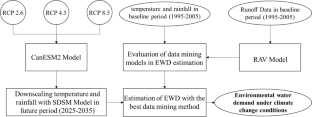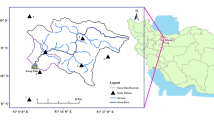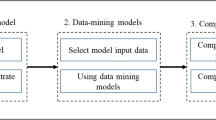Abstract
This paper presents a statistical approach based on data mining to estimate the riverine environmental water demand (EWD). A river’s environmental water demand defines the quantity, timing, and quality of streamflow that are required to sustain riverine ecosystems and human activities. Genetic programming (GP), artificial neural network (ANN), and support vector regression (SVR) are herein applied to model the environmental demand. Input and output data for the use of GP, ANN, and SVR are the average monthly temperature and precipitation in 1995–2005 plus climate projections by the Canadian Land System Model (CanESM2) under the recommended concentration pathways RCPs 2.6, 4.5 and 8.5 in 2025–2035. A case study illustrates this paper’s methodology using temperature and precipitation data and monthly discharge of the Karaj River, Iran. The applied data mining models were evaluated with R2, RMSE, and the NSE criteria. This work’s results show that the largest values of R2 and the NSE equal respectively 0.94 and 0.95, and the smallest value of the RMSE equals 0.07, which correspond to the SVR predictions. These results establish that SVR is a suitable model for the purpose of estimating the environmental water demand in comparison to GP and ANN in the study area. The SVR projections indicate that by 2035 and under the RCPs 2.6, 4.5, and 8.5 projected changes of the environmental water demand with respect to baseline conditions would be respectively 63, 118, and 126 m3/s. It is demonstrated in this work that under climate change conditions the correlation between the EWD index and temperature was 83%, while the said value for rainfall was estimated to be 76%.






Similar content being viewed by others
Data availability
The data that support the findings of this study are available from the corresponding author upon reasonable request.
Code availability
The codes that support the findings of this study are available from the corresponding author upon reasonable request.
References
Abbass K, Qasim MZ, Song H, Murshed M, Mahmood H, Younis I (2022) A review of the global climate change impacts, adaptation, and sustainable mitigation measures. Environ Sci Pollut Res 29:1–21
Abualigah L, Dulaimi AJ (2021) A novel feature selection method for data mining tasks using hybrid sine cosine algorithm and genetic algorithm. Clust Comput 24(3):2161–2176
Ahmadzadeh H, Mansouri B, Fathian F, Vaheddoost B (2022) Assessment of water demand reliability using SWAT and RIBASIM models with respect to climate change and operational water projects. Agric Water Manag 261:107377
Akbari-Alashti H, Bozorg-Haddad O, Fallah-Mehdipour E, Mariño MA (2014) Multi-reservoir real-time operation rules: a new genetic programming approach. Proc Inst Civ Eng Water Manag 167(10):561–576. https://doi.org/10.1680/wama.13.00021
Al-Juboori AM (2022) Solving complex r-runoff processes in semi-arid regions using hybrid heuristic model. Water Resour Manage 36(2):717–728
Arefinia A, Bozorg-Haddad O, Oliazadeh A, Loáiciga HA (2020) Reservoir water quality simulation with data mining models. Environ Monit Assess 192(7):1–13
Arefinia A, Bozorg-Haddad O, Keller AA (2021b) “Risk, uncertainty, and reliability in water resources management” essential tools for water resources analysis, planning, and management. Springer Nature Singapore, Singapore, pp 323–343
Arefinia A, Bozorg-Haddad O, Chang H (2021a) “The role of data mining in water resources management” essential tools for water resources analysis, planning, and management. Springer Nature Singapore, Singapore, pp 85–99
Arefinia A, Bozorg-Haddad O, Ahmadaali K, Bazrafshan J, Zolghadr-Asli B, Chu X (2022a) Estimation of geographical variations in virtual water content and crop yield under climate change: comparison of three data mining approaches. Environ Dev Sustain 24(6):8378–8396
Arefinia A, Bozorg-Haddad O, Akhavan M, Baghbani R, Heidary A, Zolghadr-Asli B, Chang H (2022a) Using support vector machine (SVM) in modeling water resources systems. In: Computational intelligence for water and environmental sciences, pp 179-199
Beygi S, Bozorg-Haddad O, Fallah-Mehdipour E, Mariño MA (2014) Bargaining models for optimal design of water distribution networks. J Water Resour Plan Manag 140(1):92–99. https://doi.org/10.1061/(ASCE)WR.1943-5452.0000324
Bozorg-Haddad O, Mariño MA (2007) Dynamic penalty function as a strategy in solving water resources combinatorial optimization problems with honey-bee mating optimization (HBMO) algorithm. J Hydroinf 9(3):233–250. https://doi.org/10.2166/hydro.2007.025
Bozorg-Haddad O, Mariño MA (2011) Optimum operation of wells in coastal aquifers. Proc Inst Civ Eng Water Manag 164(3):135–146. https://doi.org/10.1680/wama.1000037
Bozorg-Haddad O, Moradi-Jalal M, Mirmomeni M, Kholghi MKH, Mariño MA (2009a) Optimal cultivation rules in multi-crop irrigation areas. Irrig Drain 58(1):38–49. https://doi.org/10.1002/ird.381
Bozorg-Haddad O, Afshar A, Mariño MA (2009b) Optimization of non-convex water resource problems by honey-bee mating optimization (HBMO) algorithm. Eng Comput 26(3):267–280. https://doi.org/10.1108/02644400910943617
Bozorg-Haddad O, Mirmomeni M, Mariño MA (2010a) Optimal design of stepped spillways using the HBMO algorithm. Civ Eng Environ Syst 27(1):81–94. https://doi.org/10.1080/10286600802542465
Bozorg-Haddad O, Mirmomeni M, Zarezadeh Mehrizi M, Mariño MA (2010b) Finding the shortest path with honey-bee mating optimization algorithm in project management problems with constrained/unconstrained resources. Comput Optim Appl 47(1):97–128. https://doi.org/10.1007/s10589-008-9210-9
Bozorg-Haddad O, Rezapour-Tabari MM, Fallah-Mehdipour E, Mariño MA (2013) Groundwater model calibration by meta-heuristic algorithms. Water Resour Manag 27(7):2515–2529. https://doi.org/10.1007/s11269-013-0300-9
Bozorg-Haddad O, Ashofteh PS, Mariño MA (2015) Levee layouts and design optimization in protection of flood areas. J Irrig Drain Eng 141(8):04015004. https://doi.org/10.1061/(ASCE)IR.1943-4774.0000864
Bozorg-Haddad O, Janbaz M, Loáiciga HA (2016) Application of the gravity search algorithm to multi-reservoir operation optimization. Adv Water Resour 98:173–185. https://doi.org/10.1016/j.advwatres.2016.11.001
Bozorg-Haddad O, Soleimani S, Loáiciga HA (2017a) Modeling water-quality parameters using a genetic algorithm–least squares support vector regression and genetic programming. J Environ Eng 143(7):04017021
Bozorg-Haddad O, Soleimani S, Loáiciga HA (2017b) Modeling water-quality parameters using genetic algorithm-least squares support vector regression and genetic programming. J Environ Eng 143(7):04017021. https://doi.org/10.1061/(ASCE)EE.1943-7870.0001217
Bozorg-Haddad O, Delpasand M, Loáiciga HA (2020a) Self-optimizer data-mining method for aquifer level prediction. Water Sci Technol Water Supply 20(2):724–736
Bozorg-Haddad O, Zolghadr-Asli B, Sarzaeim P, Aboutalebi M, Chu X, Loáiciga HA (2020b) Evaluation of water shortage crisis in the middle east and possible remedies. J Water Supply Res Technol AQUA 69(1):85–98
Cramer NL (1985) A representation for the adaptive generation of simple sequential programs. In: Proceedings of an international conference on genetic algorithms and their applications
Fallah-Mehdipour E, Bozorg-Haddad O, Beygi S, Mariño MA (2011) Effect of utility function curvature of Young’s bargaining method on the design of WDNs. Water Resour Manag 25(9):2197–2218. https://doi.org/10.1007/s11269-011-9802-5
Fallah-Mehdipour E, Bozorg-Haddad O, Mariño MA (2013a) Extraction of multicrop planning rules in a reservoir system: application of evolutionary algorithms. J Irrig Drain Eng 139(6):490–498. https://doi.org/10.1061/(ASCE)IR.1943-4774.0000572
Fallah-Mehdipour E, Bozorg-Haddad O, Mariño MA (2013b) Extraction of optimal operation rules in an aquifer-dam system: genetic programming approach. J Irrig Drain Eng 139(10):872–879. https://doi.org/10.1061/(ASCE)IR.1943-4774.0000628
Ghoreishi M, Razavi S, Elshorbagy A (2021) Understanding human adaptation to drought: agent-based agricultural water demand modeling in the Bow river basin. Can Hydrol Sci J 66(3):389–407
Gill MK, Asefa T, Kaheil Y, McKee M (2007) Effect of missing data on the performance of learning algorithms for hydrologic predictions: implications to an imputation technique. Water Resour Res. https://doi.org/10.1029/2006WR005298
Hailu R, Tolossa D, Alemu G (2018) Integrated water resources management as a system approach for water security: evidence from the Awash river basin of Ethiopia. Ethiop J Soc Sci Humanit 14(1):53–82
Karimi-Hosseini A, Bozorg-Haddad O, Mariño MA (2011) Site selection of raingauges using entropy methodologies. Proc Inst Civ Eng Water Manag 164(7):321–333. https://doi.org/10.1680/wama.2011.164.7.321
Kelleher JD, Tierney B (2018) Data science. MIT Press, Cambridge
Khelifa R, Mahdjoub H, Baaloudj A, Cannings RA, Samways MJ (2021) Effects of both climate change and human water demand on a highly threatened damselfly. Sci Rep 11(1):1–11
King J, Louw D (1998) Instream flow assessments for regulated rivers in South Africa using the building block methodology. Aquat Ecosyst Health Manag 1(2):109–124
King J, Brown C, Sabet H (2003) A scenario-based holistic approach to environmental flow assessments for rivers. River Res Appl 19(5–6):619–639
Koza JR (1992) Genetic programming: on the programming of computers by means of natural selection. MIT Press, Cambridge
Koza JR (1994) Genetic programming II: automatic discovery of reusable programs. MIT Press, Cambridge
Li X, Wang Y, Liu G (2019) Structured medical pathology data hiding information association mining algorithm based on optimized convolutional neural network. IEEE Access 8:1443–1452
Linnansaari T, Monk WA, Baird DJ, Curry RA (2012) Review of approaches and methods to assess environmental flows across Canada and internationally. Fish Oceans Can Sci
Malla FA, Mushtaq A, Bandh SA, Qayoom I, Hoang AT (2022) “Understanding climate change: scientific opinion and public perspective” climate change. Springer, Cham, pp 1–20
Mengistu D, Bewket W, Dosio A, Panitz HJ (2021) Climate change impacts on water resources in the upper blue Nile (Abay) River Basin, Ethiopia. J Hydrol 592:125614
Mohammad-Azari SM, Bozorg-Haddad O, Loáiciga HA (2020) State-of-art of genetic programming applications in water-resources systems analysis. Environ Monit Assess 192(2):1–17
Mozaffari GA (2022) Climate change and its consequences in agriculture. In: The nature, causes, effects, and mitigation of climate change on the environment, 83
Oliazadeh A, Bozorg-Haddad O, Mani M, Chu X (2021) Developing an urban runoff management model by using satellite precipitation datasets to allocate low impact development systems under climate change conditions. Theor Appl Climatol 146:675–687
Oliazadeh A, Bozorg-Haddad O, Pakdaman M, Baghbani R, Loáiciga HA (2022) Optimal merging of multi-satellite precipitation data in urban areas. Theoret Appl Climatol 147(3–4):1697–1712
Orouji H, Bozorg-Haddad O, Fallah-Mehdipour E, Mariño MA (2014) Extraction of decision alternatives in project management: application of hybrid PSO-SFLA. J Manag Eng 30(1):50–59. https://doi.org/10.1061/(ASCE)ME.1943-5479.0000186
Richter BD, Baumgartner JV, Powell J et al (1996) A method for assessing hydrologic alteration within ecosystems. Conserv Biol 10(4):1163–1174
Richter BD, Baumgartner JV, Wigginton R et al (1997) How much water does a river need? Freshw Biol 37(1):231–249
Richter BD, Baumgartner JV, Braun DP et al (1998) A spatial assessment of hydrologic alteration within a river network. River Res Appl 14(4):329–340
Sabbaghpour S, Naghashzadehgan M, Javaherdeh K, Bozorg-Haddad O (2012) HBMO algorithm for calibrating water distribution network of Langarud city. Water Sci Technol 65(9):1564–1569. https://doi.org/10.2166/wst.2012.045
Sarzaeim P, Bozorg-Haddad O, Bozorgi A, Loáiciga HA (2017a) Runoff projection under climate change conditions with data-mining methods. J Irrig Drain Eng 143(8):04017026
Sarzaeim P, Bozorg-Haddad O, Fallah-Mehdipour E, Loáiciga HA (2017b) Environmental water demand assessment under climate change conditions. Environ Monit Assess 189(7):1–18
Sedighkia M, Abdoli A, Datta B (2021) Optimizing monthly ecological flow regime by a coupled fuzzy physical habitat simulation–genetic algorithm method. Environ Syst Decis 41(3):425–436
Soltanjalili M, Bozorg-Haddad O, Mariño MA (2011) Effect of breakage level one in design of water distribution networks. Water Resour Manag 25(1):311–337. https://doi.org/10.1007/s11269-010-9701-1
Tan P-N, Steinbach M, Karpatne A, Kumar V (2019) Introduction to data mining. Person Educ Inc., New York
Tennant DL (1976) Instream flow regimens for fish, wildlife, recreation and related environmental resources. J Fish 1(4):6–10
Than NH, Ly CD, Van Tat P (2021) The performance of classification and forecasting Dong Nai River water quality for sustainable water resources management using neural network techniques. J Hydrol 596:126099
Tharme RE (2003) A global perspective on environmental flow assessment: emerging trends in the development and application of environmental flow methodologies for rivers. River Res Appl 19(5–6):397–441
Tian J, Guo S, Deng L, Yin J, Pan Z, He S, Li Q (2021) Adaptive optimal allocation of water resources respoNSE to future water availability and water demand in the Han river basin, China. Sci Rep 11(1):1–18
Vapnik V (1995) The nature of statistical learning theory. Springer, New York
Wang Y, Liu P, Dou M, Li H, Ming B, Gong Y, Yang Z (2021) Reservoir ecological operation considering outflow variations across different time scales. Ecol Ind 125:107582
Wilby R, Dawson CW (2013) The Statistical downscaling model: insights from one decade of application. Int J Climatol 33(7):1707–1719
Zolghadr-Asli B, Bozorg-Haddad O, Chu X (2019) Effects of the uncertainties of climate change on the performance of hydropower systems. J Water Clim Chang 10(3):591–609
Acknowledgements
The authors thank Iran’s National Science Foundation (INSF) for its support for this research.
Funding
No funding was received for conducting this study specifically.
Author information
Authors and Affiliations
Contributions
Masoud Zanjani: software, formal analysis, writing—original draft. Omid Bozorg-Haddad: conceptualization, supervision, project administration. Mustafa Zanjani: software, formal analysis, writing—original draft. Ali Arefinia: software, formal analysis, writing—original draft. Masoud Pourgholam-Amiji: software, formal analysis, writing—original draft. Hugo A. Loáiciga: validation, writing—review and editing.
Corresponding author
Ethics declarations
Conflict of interest
There is no conflict of interest.
Consent to participate
All authors consent to participate.
Consent for publish
All authors consent to publish.
Ethical approval
All authors accept all ethical approvals.
Additional information
Publisher's Note
Springer Nature remains neutral with regard to jurisdictional claims in published maps and institutional affiliations.
Rights and permissions
Springer Nature or its licensor (e.g. a society or other partner) holds exclusive rights to this article under a publishing agreement with the author(s) or other rightsholder(s); author self-archiving of the accepted manuscript version of this article is solely governed by the terms of such publishing agreement and applicable law.
About this article
Cite this article
Zanjani, M., Bozorg-Haddad, O., Zanjani, M. et al. Estimating the riverine environmental water demand under climate change with data mining models. Nat Hazards (2024). https://doi.org/10.1007/s11069-024-06656-4
Received:
Accepted:
Published:
DOI: https://doi.org/10.1007/s11069-024-06656-4




